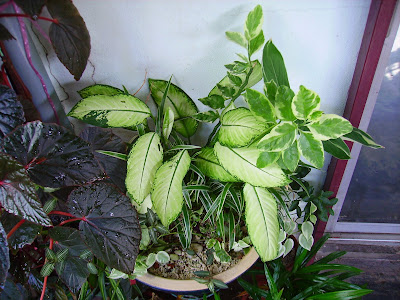
Its known as rain lilies because of their habit of blooming several times a season, usually following a rain. I'm not sure about that but I often noticed is that when a grass cutter comes around and accidentally cut the whole crown together with other weeds thinking that this is one of them.
And the gardener gets a reward with a showy springs of new sprouts of flower scape - usually within 2 - 3 days time. And this happens every time. (I had trimmed the leaves after planting and they gave 4 flowers immediately)
The leaves look very much like grass, that is if you are not accustom to rainlilies - you would wonder why do a gardener breed weeds. I had several pots of these and none of them bloomed for months. (planted first - July 09) One thing for sure, they really had multiplied from the first batch.
You can see it here how I first started:
RainlilyI have decided to put them in a long rectangular pot instead of the circular ones - they seemed to look prettier this way. I also manage to do the same for my Amaryllis bulbs - something which I had never seen them bloom, so I'm really not sure how they look like.
I have been reading a lot these few days about blooming Amaryllis but as for now, I had replanted them back and so I do not want to damage them in uprooting them again. Probably I will keep watch over these for another couple of months and see, If they do not bloom, chances are I might just uproot them and throw them away (Just kidding)
A more drastic move may be removing them and place them in dormancy & later "force bloom" them. See if these changes their mind and give their precious blooms soon.
These were passed to me by my mum last year as she had gave up on them.
Some tips to consider:1) Rainlilies need a good amount of sunlight, they may not bloom in shaded area.
2) Its been said also that over watering can cause bulb rot - so do watch out for that.
3) They will also seed freely, do collect them if you are planning to plant them using seeds.
4) Do not uproot them by putting them out from the soil, rather you may need to turn the pot upside down and slowly break the soil-bound roots and loose the bulb and slowly remove them to save the pups. It would be very difficult to remove the bulbs once planted directly on the ground - unless you intend to keep them there permanently, consider planting them on pots then place them on the soil for easier digging & etc.
I have tried to pull a bulb planted in an abandoned area but I was unsuccessful as the bulb had gone very strong with roots and all and I manage only to get some of the succulent leaves in my few failed attempts. Probably a spade might help but there may be some damage occurring on the bulb & the roots.





.
The bulbs had given a lot of "pups" by the sides -these what they have been doing sitting in the pot, instead of flowering, they have been making babies.
.
.
The rain was heavy for these few days and had washed the top soil that had covered the 1/3 of the bulb. May have to top some soil later.
.







































































